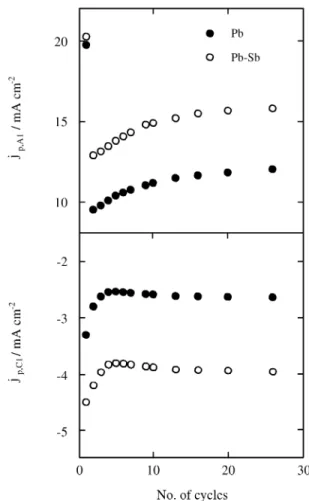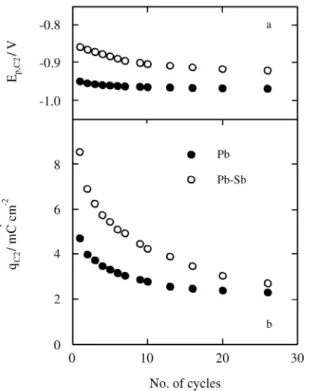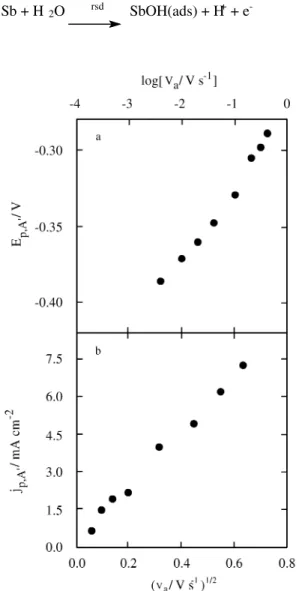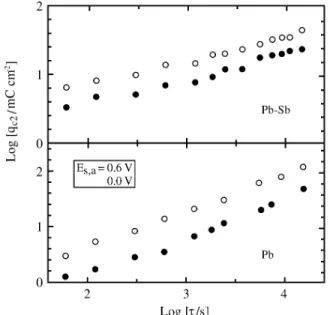A Comparative Kinetic Study of Pb and Pb-Sb Electrodes in
Sulfuric Acid Solutions
E.N. Codaro, and F.E. Varela*
Instituto de Investigaciones Fisicoquímicas Teóricas y Aplicadas (INIFTA), Fac. de
Cs.Ex. (U.N.L.P.), Sucursal 4 - C.C. 16, (1900) La Plata, Ar gen tina
Re ceived: June 30, 1996; Jan u ary 20, 1997
As respostas eletroquímicas de eletrodos de Pb e de Pbs-3.4%Sb em H2SO4 5 M foram examinadas combinando as técnicas de varredura e saltos de potencial. A presença do antimônio evita o bloqueio completo da superfície ativa do eletrodo por cristais de PbSO4 du -rante a eletrooxidação, mudando a composição e a estrutura da camada passiva. A eletrooxidação do Sb tem sido interpretada em termos de um mecanismo de adsorção-dissolução onde um elétron é transferido na etapa determinante da velocidade. A cinética de crescimento da camada interna de PbO também tem sido estudada. No eletródo de Pb-Sb, a velocidade de crescimento do PbO diminui devido a uma mudança no mecanismo de transporte dos íons através da camada anódica.
The elec tro chem i cal re sponses of Pb and Pb-3.4% Sb elec trodes in 5 M H2SO4 were ex am ined com bin ing po ten tial sweep and po ten tial step tech niques. The pres ence of an ti mony pre -vents the com plete block age of the elec trode ac tive sur face by PbSO4 crys tals dur ing elec trooxidation, chang ing the com po si tion and struc ture of the pas sive layer. The elec -tro-oxidation of Sb was in ter preted in terms of an ad sorp tion-dissolution mech a nism where in the rate-determining step one elec tron is trans ferred. The growth ki net ics of the PbO in ner layer was also stud ied. On the Pb-Sb elec trode, the growth rate of PbO de creases be cause of a change in the trans port mech a nism of ions through the an odic layer.
Key words: lead-antimony/sul fu ric acid sys tem, lead-antimony elec tro-oxidation, lead-antimony al loy elec tro chem i cal be hav ior
In tro duc tion
In a lead-acid bat tery, the per for mance of pos i tive plates de pends on the grid cor ro sion pro cesses and the soft -en ing and shed ding of PbO2 elec trode ac tive ma te rial1. An
-ti mony is widely used as a grid al loy ing el e ment for this kind of bat tery. How ever, the ex act in flu ence of Sb on the chem i cal na ture of the re ac tion prod ucts and on the mor -phol ogy of the pos i tive elec trode ac tive ma te rial is still open to dis cus sion.
There is gen eral agree ment on some stages in volved in the over all re ac tion of Pb and Pb-Sb elec trodes in sul fu ric acid elec tro lytes. Dur ing an odic po lar iza tion, the re ac tion be tween Pb2+ and SO42- ions oc curs, and a semi-permeable
PbSO4 crys tal layer is formed. In or der to main tain
electroneutrality, the so lu tion in the pores is al ka lized as a
re sult of wa ter dis so ci a tion and the mi gra tion of H+ ions from the in ner layer to the bulk so lu tion, whereby a pH gra -di ent ap pears. At an o-dic po ten tials higher than 0.23 V vs.
NHE, the elec tro-oxidation of Sb and the for ma tion of
tet-PbO be gin, and sev eral chem i cal re ac tions take place, re sult ing in the for ma tion of sub sti tuted lead an ti mony ox -ides and SbO+ ions2. Thus, the an odic layer is com posed of
PbSO4 and an in ner film in volv ing ba sic Pb(II)- and
Sb(III)con tain ing com pounds (like ba sic sul fates, hy drox -ides and ox -ides) which builds up pro gres sively be neath the ini tial PbSO4 po rous layer struc ture3.
The pur pose of the pres ent re search is to study the elec tro chem i cal be hav ior of Pb and Pb-Sb elec trodes in 5 M H2SO4 un der con trolled con di tions in or der to quan ti
-ta tively eval u ate the pres ent phases in the an odic layer.
Ex per i men tal
The ex per i men tal setup has been de scribed in pre vi ous pub li ca tions4,5. “Specpure” lead and lead-antimony (3.4
wt% Sb) al loy disks (John son Matthey Chem i cals, 0.30 cm2 ap par ent area) em bed ded in PTFE hold ers were used
as the work ing elec trodes in 5 M H2SO4 at 25 °C, un der pu
ri fied ni tro gen gas sat u ra tion. The elec trodes were me chan -i cally pol -ished w-ith 600 and 1200 grade em ery pa pers and thor oughly rinsed in four fold dis tilled wa ter. Po ten tials were mea sured and re ferred to in the text, against a Hg/Hg2SO4, K2SO4 (sat.) ref er ence elec trode.
Prior to the elec tro chem i cal runs, work ing elec trodes were cathodized for 5 min at -1.30 V,i.e. in the hy dro gen evo lu tion re ac tion (HER) po ten tial range, to achieve a re pro duc ible electroreduced elec trode sur face. Sub se
-quently, two types of ex per i ments were made: i)
char ac ter is tic cur rent den sity/po ten tial (j/E) curves un der dif fer ent hy dro dy namic con di tions were re corded by ap -ply ing ei ther sin gle (STPS) or re pet i tive (RTPS) tri an gu lar po ten tial sweeps be tween pre set cath odic (Es,c = -1.30 V)
and an odic (Es,a) switch ing po ten tials at scan rate v, in clud
-ing a po ten tial hold -ing at Es,a for dif fer ent times τ; ii) com
-bined lin ear po ten tial scans with po ten tial steps were used to study the elec tro-oxidation pro cess of an ti mony dur ing the for ward po ten tial sweep.
Re sults and Dis cus sion
The voltammogram of Pb in 5 M H 2SO 4 so lu tion at v = 0.04 V s-1 run be tween Es,c = -1.30 V and Es,a = 1.40 V
(Fig. 1) shows an an odic cur rent peak (A1) at ca. -0.96 V fol lowed by a wide pas sive re gion dur ing the for ward po -ten tial sweep6. Dur ing the re verse scan, two cath odic cur
-rent peaks, C1 and C2, are ob served at -1.11 V and -0.95 V, re spec tively. Con ju gated cur rent peaks A1 and C1 cor re -spond to the elec tro-oxidation of Pb to PbSO4 and to the
electroreduction of PbSO47,8, whereas peak C2 may be as
-so ci ated with the electroreduction of PbO which builds up pro gres sively be neath the ini tial PbSO4 po rous layer9.
Elec tro chem i cal mea sure ments per formed us ing the Pb3.4%Sb elec trode (Fig. 1) re veal ad di tional cur rent con -tri bu tions: two an odic cur rent peaks at -0.37 and -0.15 V (A’ and A’’) lo cated in the re gion of sta ble Pb(II) sur face com pounds, and two cath odic peaks (C’ and C’’) at -0.69 and -0.86 V pre ced ing the PbSO4 electroreduction po ten
-tial range. Cur rent peaks A’ and C’ may be re lated to the electroformation and electroreduction of the Sb(III) spe cies, whereas the broad peaks A’’ and C’’ seem to be as so -ci ated with the for ma tion of Sb(III) com plexes and the com plex electroreduction of ba sic Pb(II)Sb(III) con tain -ing sur face com pounds (C2-C’’), re spec tively. The whole potentiodynamic re sponse is prac ti cally in de pend ent of the so lu tion stir ring con di tions.
The anal y sis of peak pa ram e ters dur ing con sec u tive potentiodynamic charge/dis charge cy cles be tween
Fig ure 1. Com par a tive voltammograms of Pb (full curve) and Pb-Sb (dashed curve) elec trodes in 5 M H2SO4 so lu tion run at v = 0.040 V s-1
be tween Es,c = -1.30 V and Es,a = 1.40 V.
Fig ure 2. The dependences of jp,A1 and jp,C1 on the num ber of cy cles
Es,c = -1.30 V and Es,a = 1.40 V at v = 0.04 V s-1 on both Pb
and Pb-Sb elec trodes, re veals grad ual struc tural changes of the pas si vat ing layer (Fig. 2). The height of con ju gated cur rent peaks A1 and C1 de creases abruptly in the ini tial cy -cles, reaches a min i mum cur rent value, and then in creases slowly to at tain a sta bi lized re sponse af ter about twenty cy -cles. More over, the peak po ten tials Ep,A1 and Ep,C1 re main
prac ti cally con stant dur ing cy cling. On the other hand, peak C2 grad u ally tends to wards more neg a tive po ten tials and its charge den sity (qC2) de creases to ap proach the sta
-tion ary value af ter pro longed cy cling (Fig. 3). The voltammetric charge in volved in cur rent peaks A1, C1, and C2 for mea sure ments per formed us ing Pb elec trodes is smaller than that re corded em ploy ing Pb-Sb elec trodes (Figs. 2 and 3b). The dis so lu tion of the Sb(III) spe cies in -creases the per me abil ity of the pas sive layer. The Pb ions can then dif fuse more eas ily through the an odic film and the pH in side the pas sive layer de creases. This ex plains the fact that the charge and re duc tion overpotentials of ba sic Pb(II) com pounds de crease more quickly for al loy elec trodes dur -ing cy cl-ing.
The height of cur rent peaks A’ and C’, which are ob -tained with Pb-Sb elec trodes and are re lated to the electroformation/electroreduction of Sb(III)-con tain ing sur face spe cies, grad u ally di min ishes dur ing cy cling to at -tain sta ble val ues at about twenty cy cles (Fig. 4). The charge den sity ra tio of peaks A’ and C’ is prac ti cally con -stant (q A’ /q C’ » 4) with both the num ber of cy cles and po -ten tial scan rate, at least up to the 50th po ten tial cy cle and
for v val ues within the 0.02 V s-1≤ v ≤ 0.20 V s-1 range, re
-spec tively. The same elec tro chem i cal be hav ior for Es,a=
0.00 V was also ob served. This sug gests that the for ma tion and re duc tion pro cesses of Sb(III)-con tain ing spe cies take place at pref er en tial sur face sites lim ited to the ar eas un -blocked by re sid ual lead sul fate, which seems to be highly re sis tant to pro longed electroreduction10,11. More over,
these re sults im ply that only the ions near est to the elec -trode sur face can be electroreduced, i.e. those as so ci ated with the ad sorp tion mech a nism. There fore, for high cy cle num ber, the dis so lu tion pro cess ap pears to be in hib ited by chemisorption of [Sb(SO4)2]- or [SbOSO4]- an ions. On the
other hand, the change of jp,A’ and jp,C’ dur ing ini tial po ten
-tial cy cles may be as so ci ated with the grad ual for ma tion of a more reg u lar struc ture of the sur face layer (i.e. a more ho -mo ge neous size of the PbSO4 crys tals) and, ac cord ingly,
the de crease of voltammetric charge den sity of peaks A’, C’ and C2 can be re lated to pro cesses which con trib ute to en hance sur face layer po ros ity. These con clu sions agree with scan ning elec tron mi cros copy (SEM) re sults ob tained on Pb and Pb-Sb elec trodes un der sim i lar ex per i men tal con di tions by Bialacki et al.12 and Webster et al.13. Web -ster et al. con cluded from their ob ser va tions that an ti mony al loy elec trodes have sur face films of higher po ros ity and that the po ros ity in creases with cy cling.
The elec trooxidation of Sb to the Sb(III) spe cies at po ten tials be tween 0.50 V and 0.00 V was stud ied by po ten -tial sweep and po ten -tial step com bin ing mea sure ments. Figs. 5a and 5b pres ent the de pend ence of Ep,A’ on log va
and jp,A’ on va1/2 af ter τ = 1 min at Es,a = 0.50 V. These lin
-ear re la tion ships are typ i cal of an ir re vers ible sys tem. This is con sis tent with the fact that jp,A’ >> jp,C’ for the whole
scan rate range. Also, these re la tion ships may be as so ci ated with an EC re ac tion where the elec tron trans fer is re vers
-Fig ure 3. The dependences of (a) Ep,C2 and (b) qC2 on the number of
cy cles in both elec trode sys tems, un der the same con di tions as in Fig 2
Fig ure 4. The dependences of jp,A’ and jp,C’ on the num ber of cy cles
ible and the chem i cal re ac tion is ir re vers ible14. Thus, Ep,A’
var ies with the sweep rate as shown by the the o ret i cal equa -tion:
Ep K RT a
n F v
= −2 303
2 .
log
α α
(1)
where K is in de pend ent ofv a. The ex per i men tal slope value
is (∂Ep,A’ /∂log va) = 0.0495. Thus, the cal cu lated value of αnα is 0.6, where nα, the num ber of elec trons in volved in the rate-determining step, can be as sumed to be 1.
Taking into ac count the above con sid er ations, the elec -tro-oxidation of Sb can be in ter preted as two con sec u tive elec tronic trans fer steps and one chem i cal re ac tion, which cor re sponds to the fast dis so lu tion of an elec tro-oxidation prod uct. Ac cord ingly, the electroreduction charge dur ing the neg a tive po ten tial sweep is smaller than that de vel oped in the elec tro-oxidation pro cess.
Sb + H2O rsd SbOH(ads) + H+ + e- (2)
SbOH(ads) + H2O SbO.OH(ads) +
+ 2 H+ + 2 e- (3)
SbO.OH(ads) + H+ SbO+ + H2O (4)
The pH de crease re sult ing from steps (2) and (3) con trib utes to the dis so lu tion of the an odic layer ba sic com -pounds, ox ides and hy drox ides of Sb(III), as well as those of Pb(II).
To in ves ti gate the electroformation of PbSO4 and
PbO lay ers, the Pb and Pb-Sb elec trodes were an od ized at sev eral Es,a in the pas sive po ten tial range for dif fer ent po
-lar iza tion times (τ). From the anal y sis of electroreduction peak C1, it was found that the amount of PbSO4 formed on
Pb elec trodes is al most in de pend ent of po ten tial and in -creases slightly with τ (Fig. 6a,b), in agree ment with re -ported data15. On Pb-Sb elec trodes, on the other hand, the
Fig ure 5. The dependences of (a) Ep,A’ and (b) jp,A’ on va. Data ob
-tained from voltammograms re corded in the po ten tial re gion of peaks A’ and A’’, af ter τ = 1 min at Es,a = -0.50 V.
Fig ure 6. The dependences of qC1 and qC2 on Es,a for dif fer ent an odic
peak C1 charge de pends on Es,a, and is higher than that ob
-tained on Pb elec trodes.
Figs. 6c and 6d show that the PbO electroreduction charge in creases lin early with the po ten tial, but the rel a tive amounts for Pb and Pb-Sb elec trodes shown an in ver sion with τ. This can be ex plained by a dis so lu tion of the small crys tals of ba sic Sb(III) com pounds dur ing an od iza tion.
From the log qC2vs. log τ plot (Fig. 7), lin ear re la tion
-ships for each Es,a in the 0.0 to 0.6 V po ten tial range are ob
-tained. Higher PbO growth rates on Pb than those on Pb-Sb are ob tained, and the ra tio be tween both PbO charge den si -ties, that ob tained on Pb and that on Pb-Sb, gives re sults pro por tional to τ1/3. As the charge den sity qC’ is prac ti cally
in de pend ent of Es,a and τ, these re sults im ply that the dis so
-lu tion pro cess of Sb(III)-con tain ing spe cies within the pores mod i fied the trans port mech a nism of the ions (i.e.H+, OH-) through the an odic layer and the growth ki net ics of the PbO in ner film.
Con clu sions
Voltammetric re sults ob tained on PbSb al loy elec -trodes show that the or der within the an odic layer struc ture in creases with potentiodynamic cy cling, and the elec trooxidation/electroreduction of Sb spe cies oc curs at pref -er en tial sites on the sur face. Theelectrooxidation of Sb
may be as so ci ated with an ad sorp tiondissolution mech a -nism where one elec tron is trans ferred i n t h e rate-determining step. The growth rate of the PbO in ner film on PbSb elec trodes is smaller than that on Pb elec -trodes, due to a change in the trans port mech a nism of ions (OH- or H+) through the an odic layer.
Ac knowl edg ments
This re search pro ject was fi nan cially sup ported by the Consejo Nacional de Investigaciones Científicas y Técnicas and the Comisión de Investigaciones Científicas de la Provincia de Bue nos Ai res.
Ref er ences
1.Ad vances in Lead-Acid Bat teries; Bull ock, K.R.; Pav -lov, D., Eds.; The Elec tro chem i cal So ci ety, N.J., 1984.
2. Laihonen, S.; Laitinen, T.; Sundholm, G.; Yli-Pentti , A.Electrochim. Acta1990, 35, 229.
3. Pav lov, D.; Monahov, B.; Sundholm, G.; Laitinen, T.
J. Electroanal. Chem.1991, 305, 57.
4. Varela, F.E.; Codaro, E.N.; Vilche, J.R. J. Braz.
Chem. Soc.1994, 5, 145.
5. Varela, F.E.; Gassa, L.; Vilche, J.R. J. Appl.
Electrochem. 1995, 25, 358.
6. Varela, F.E.; Gassa, L.; Vilche, J.R. J. Electroanal. Chem.1993, 353, 147.
7. Varela, F.E.; Vela, M.E.; Vilche, J.R.; Arvia, A.J.
Electrochim. Acta1993, 38, 1513.
8. Varela, F.E.; Vilche, J.R.; Arvia, A.J. Electrochim. Acta1994, 39, 401.
9. Varela, F.E.; Codaro, E.N.; Vilche, J.R. Electrochim. Acta1995, 40, 1183.
10. Guo, Y.; Chen, J. J. Electrochem. Soc. 1992, 139, L99.
11. Trettenhahn, G.L.; Nauer, G.E.; Neckel, A. Ber.
Bunsenges. Phys. Chem.1993, 97, 422.
12. Bialacki, J.A.; Hampson, N.A.; Pe ters, K.; Wil liams, A.K. J. Appl. Electrochem.1983, 13, 103.
13. Web ster, S.; Mitch ell, P.J.; Hampson, N.A.; Dyson, J.I. J. Electrochem. Soc.1986, 133, 133.
14. Greef, R.; Peat, R.; Pletcher, D. In In stru men tal Methods in Elec tro-chemistry; John Wiley & Sons; N.Y., 1985, Chap. 6.
15. Guo, Y. J. Electrochem. Soc.1995, 142, 3378. Fig ure 7. The dependences of qC2 on τ for dif fer ent Es,a. Es,c = -1.30



